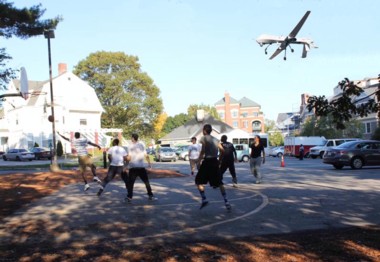Technology, when it’s applied to battlefields, often has a side effect on its users that’s talked about less than its efficiency: it distances them from the violent realities of killing. That distancing is why, for instance, we think of PTSD in relation to ground troops more often than in pilots.
Remotely piloted drones take that distancing to a whole new extreme. The pilot sits comfortably, thousands of miles from the actual deaths delivered via drone; the lack of American casualties makes it easy for the rest of us to think of those deaths in abstract terms. It’s easier to support killing that’s only witnessed by those on the receiving end.
Drones have proven so successful and so easy to support that their use is growing. Domestic drone use is underway, and they have already been used by law enforcement for surveillance. About that use, The Washington Post reported this quotation: “‘The nice thing is it’s covert,’ said Bill C. Nabors Jr., chief pilot with the Texas DPS, who in a recent interview described the 2009 operation for the first time publicly. ‘You don’t hear it, and unless you know what you’re looking for, you can’t see it.’”
According to a 2012 report in U.S. News, “Experts predict as many as 30,000 unmanned aerial vehicles [in domestic use] in a couple years—they’ll be owned by journalists, police departments, disaster rescue teams, scientists, real estate agents, and private citizens.”
Of course, that sudden influx will mean all sorts of issues come to light—how long before a private citizen starts spying or stalking? How long until someone weaponizes them?
Of most concern is the Obama administration’s claim that the government can, without court oversight, determine when an American citizen is worthy of inclusion on the target list, despite the denial of our right to due process. So far, such attacks have only happened outside our borders.
In an intriguing convergence of political questioning and art, UMass’ Hampden Gallery is hosting, until March 26, an exhibition called Home Drone. In an artistic followup to trips to Pakistan to find out more about how drones are experienced by those who live where the attacks happen, Heather Layton and Brian Bailey (who teach at University of Rochester and Nazareth College, respectively) attempt to translate the drone attack issue to a domestic setting. A massive, sequined drone hangs in the space, and, perhaps most intriguingly of all, the map of drone attack locations in Pakistan is superimposed on southern New England.
It’s hard to imagine the sorts of scenarios that filter back into American conversations—innocent families wiped out, for instance—taking place in the U.S., but it’s a vital conversation to have, especially as we stand on the brink of a new era in pervasive drone presence. How many such drones end up piloted by those who wish to use them for harm, of course, won’t be knowable.
The difficulty in making the necessary imaginative leap requires just the kind of startling imagery that Layton and Bailey employ. In the postcard (pictured) for the exhibition, a drone seems almost to drift by as unconcerned people play basketball below.
That strange kind of moment deserves a lot of attention, and the resulting artworks deserve a lot of praise for opening the door to conversation in such arresting style.
We are, even now, asking citizens of other countries to endure overhead drones, though they can clearly never be certain if or when one will strike. Will Americans tolerate the same treatment? Should we ask others to?
Then there’s most important question this kind of artwork raises, the one no one can answer yet: what new domestic realities might come of this technology, even if it was pressed into service for reasons that are perfectly understandable?•
Home Drone: Through March 26, Hampden Gallery, Southwest Residential Area, UMass-Amherst, fac.umass.edu/Online/HampdenGallery.



